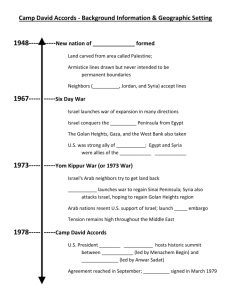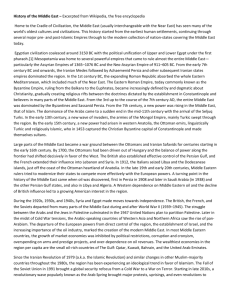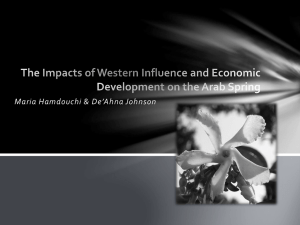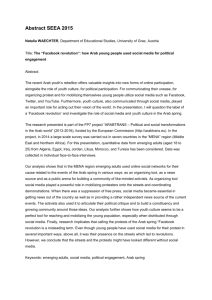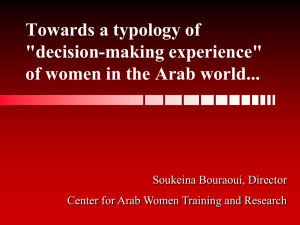Outline 20 Arab Unity and Disunity since 1967
advertisement
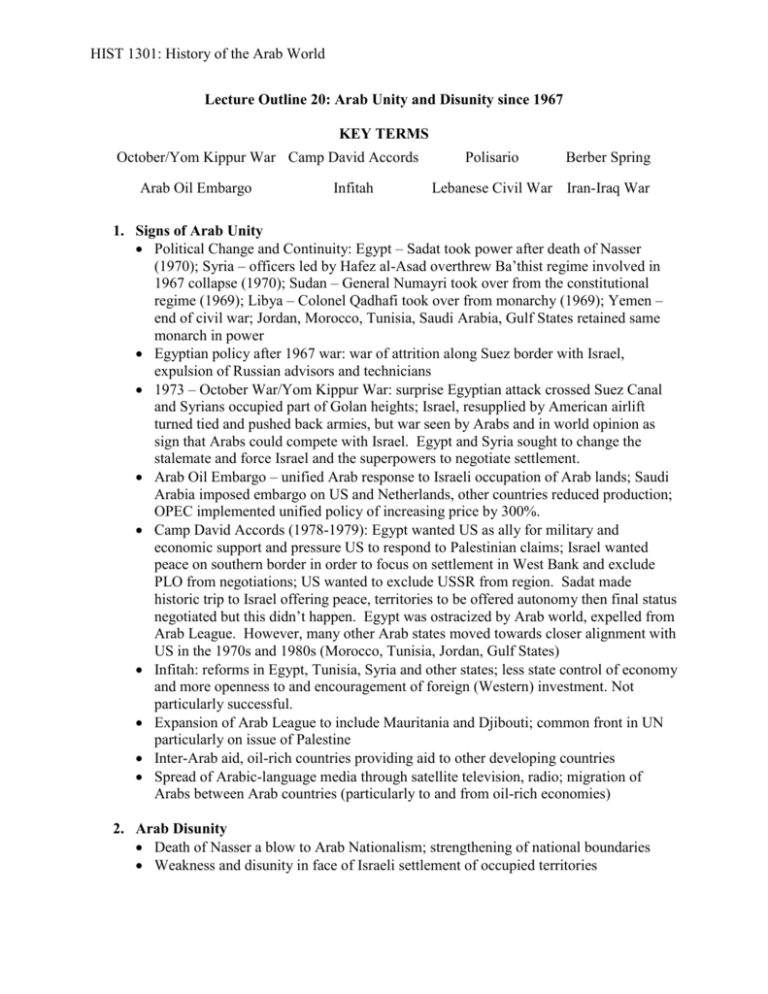
HIST 1301: History of the Arab World Lecture Outline 20: Arab Unity and Disunity since 1967 KEY TERMS October/Yom Kippur War Camp David Accords Arab Oil Embargo Infitah Polisario Berber Spring Lebanese Civil War Iran-Iraq War 1. Signs of Arab Unity Political Change and Continuity: Egypt – Sadat took power after death of Nasser (1970); Syria – officers led by Hafez al-Asad overthrew Ba’thist regime involved in 1967 collapse (1970); Sudan – General Numayri took over from the constitutional regime (1969); Libya – Colonel Qadhafi took over from monarchy (1969); Yemen – end of civil war; Jordan, Morocco, Tunisia, Saudi Arabia, Gulf States retained same monarch in power Egyptian policy after 1967 war: war of attrition along Suez border with Israel, expulsion of Russian advisors and technicians 1973 – October War/Yom Kippur War: surprise Egyptian attack crossed Suez Canal and Syrians occupied part of Golan heights; Israel, resupplied by American airlift turned tied and pushed back armies, but war seen by Arabs and in world opinion as sign that Arabs could compete with Israel. Egypt and Syria sought to change the stalemate and force Israel and the superpowers to negotiate settlement. Arab Oil Embargo – unified Arab response to Israeli occupation of Arab lands; Saudi Arabia imposed embargo on US and Netherlands, other countries reduced production; OPEC implemented unified policy of increasing price by 300%. Camp David Accords (1978-1979): Egypt wanted US as ally for military and economic support and pressure US to respond to Palestinian claims; Israel wanted peace on southern border in order to focus on settlement in West Bank and exclude PLO from negotiations; US wanted to exclude USSR from region. Sadat made historic trip to Israel offering peace, territories to be offered autonomy then final status negotiated but this didn’t happen. Egypt was ostracized by Arab world, expelled from Arab League. However, many other Arab states moved towards closer alignment with US in the 1970s and 1980s (Morocco, Tunisia, Jordan, Gulf States) Infitah: reforms in Egypt, Tunisia, Syria and other states; less state control of economy and more openness to and encouragement of foreign (Western) investment. Not particularly successful. Expansion of Arab League to include Mauritania and Djibouti; common front in UN particularly on issue of Palestine Inter-Arab aid, oil-rich countries providing aid to other developing countries Spread of Arabic-language media through satellite television, radio; migration of Arabs between Arab countries (particularly to and from oil-rich economies) 2. Arab Disunity Death of Nasser a blow to Arab Nationalism; strengthening of national boundaries Weakness and disunity in face of Israeli settlement of occupied territories HIST 1301: History of the Arab World Division between Arab states aligned with US and those aligned with USSR or neutral (Algeria, Libya, Syria, Iraq, South Yemen, PLO); hostility between Ba’th regimes in Syria and Iraq; friction with Qhadafi’s Libya War over Sahara: upon Spanish withdrawal Morocco and Mauritania split territory between them, Polisario resistance movement succeeded in expelling Mauritania (1979) after which Morocco annexed all of territory, decade of warfare between Morocco and Polisario until construction by Morocco of wall Lebanese Civil War: breakdown of National Pact (Lebanon would be independent of Syria but part of Arab world); division of political power among Maronites, Sunnis, and Druze did not reflect demographic realities; 1958 Civil War; entrance of PLO activity in early 1970s; outbreak of civil war in 1975 between PLO, Phalangists, with Syria and Israel supporting different factions; Syria sent in troops to keep balance in 1976; five years of truce (Maronites in north, PLO in south, and Syrians in east); 1982 – Israel invaded Lebanon seeking to destroy PLO; siege of Western Beirut and evacuation of PLO to Tunisia; Kata’ib (Phalangist) massacre of Palestinians in Sabra and Shatila refugee camps following assassination of Bashir Jumayyil. US involvement and stationing of Marines in Beirut then withdrawal following suicide bombings. Amal and Hizbollah emerge as dominant Shi’i groups. Iran-Iraq War (1980-1988): threat of Iranian Revolution; dispute over frontier; Saddam Hussein orders invasion; Syrian support for Iran and other Sunni state support for Iraq. 3. Ethnic, Religious, Socio-Economic, and Gender Divisions Kurdish separatism (Iraq, Turkey, Iran); revolts under British mandate; autonomy at times after independence; repression in 1980s and 1990s under Saddam Hussein Berber Spring: Algerian arabization policy following independence, suppression of Berber language and culture, beginning of protest in 1980 for recognition of Berber cultural and linguistic rights Sudan: civil war between Arab-Muslim and Black Christian/Animist south in 1980s following extension of Islamization policy from Khartoum Increased gap between rich and poor: between oil rich and non-oil producing countries; increase in military expenditures; agricultural sector neglected in favor of industry of consumer manufacturing Spread of education to women; increase in number of women working outside home (in urban areas now); women more visible in public life; conflict over changes in women’s legal status (marriage, divorce, custody of children); growth of women’s organizations; increase in secular and Islamic versions of feminism

